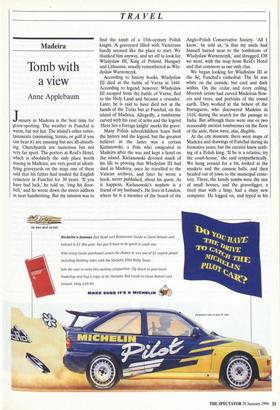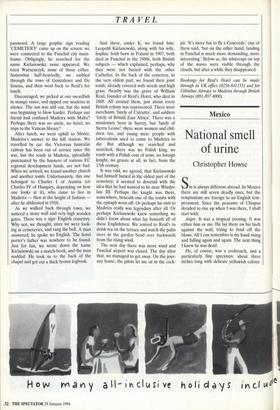TRAVEL
Madeira
Tomb with a view
Anne Applebaum
find the tomb of a 15th-century Polish knight. A graveyard filled with Victorians hardly seemed like the place to start. We thanked him anyway, and set off to look for Wladyslaw III, King of Poland, Hungary and Lithuania, usually remembered as Wla- dyslaw Warnenczyk.
According to history books, Wladyslaw III died at the battle of Varna in 1444. According to legend, however, Wladyslaw III escaped from the battle of Varna, fled to the Holy Land and became a crusader. Later, he is said to have died not at the hands of the Turks but at Funchal, on the island of Madeira. Allegedly, a tombstone carved with his coat of arms and the legend `Here lies a foreign knight' marks the grave.
Many Polish schoolchildren learn both the history and the legend, but the greatest believer in the latter was a certain Kielanowski, a Pole who emigrated to Madeira after the war and kept a hotel on the island. Kielanowski devoted much of his life to proving that Wladyslaw III had died in Madeira; once he travelled to the Vatican archives, and later he wrote a book, never published, about his quest. As it happens, Kielanowski's nephew is a friend of my husband's. He lives in London, where he is a member of the board of the Anglo-Polish Conservative Society. 'All I know,' he told us, 'is that my uncle had himself buried near to the tombstone of Wladyslaw Warnenczyk,' and shrugged. Off we went, with the map from Reid's Hotel and that comment as our only clue.
We began looking for Wladyslaw III at the Se, Funchal's cathedral. The Se was white on the outside, but cool and dark within. On the cedar and ivory ceiling, Moorish artists had carved Madeiran flow- ers and trees, and portraits of the round earth. They worked at the behest of the Portuguese, who discovered Madeira in 1418, during the search for the passage to India. But although there were one or two reasonably ancient tombstones on the floor of the aisle, these were, alas, illegible.
At the city museum, there were maps of Madeira and drawings of Funchal during its formative years, but the curator knew noth- ing of a Polish king. 'If he is a relative, try the court-house,' she said sympathetically. We hung around for a bit, looked at the muskets and the cannon balls, and then headed out of town to the municipal ceme- tery. There, the family tombs were the size of small houses, and the gravedigger, a tired man with a limp, had a shiny new computer. He logged on, and typed in his
TRAVEL
password. A large graphic sign reading `CEMETERY' came up on the screen: we were connected to the Funchal city main- frame. Obligingly, he searched for the name Kielanowski; none appeared. We tried Warnenczyk; none of those either. Somewhat half-heartedly, we ambled through the rows of Gonzaleses and De Sousas, and then went back to Reid's for lunch.
Discouraged, we picked at our swordfish in mango sauce, and sipped our madeira in silence. The sun was still out, but the wind was beginning to blow harder. Perhaps our friend had confused Madeira with Malta? Perhaps there was no uncle, no hotel, no trips to the Vatican library?
After lunch, we went uphill to Monte, Madeira's answer to the hill station. We travelled by car: the Victorian funicular railway has been out of service since the war, but the roads in Madeira, splendidly punctuated by the banners of various EC regional development funds, are not bad. When we arrived, we found another church and another tomb. Unfortunately, this one belonged to Charles I of Austria (or Charles IV of Hungary, depending on how one looks at it), who came to live in Madeira — then at the height of fashion after he abdicated in 1918.
As we walked back through town, we noticed a stone wall and very high wooden gates. There was a sign: English cemetery. Why not, we thought, since we were look- ing at cemeteries, and rang the bell. A man answered; he spoke no English. The hotel porter's father was nowhere to be found. Just for fun, we wrote down the name Kielanowski on a match-book, and the man nodded. He took us to the back of the chapel and got out a thick brown logbook. And there, under K, we found him: Leopold Kielanowski, along with his wife, Sophia: both born in Poland in 1907, both died in Funchal in the 1980s, both British subjects — which explained, perhaps, why they were not buried with the other Catholics. In the back of the cemetery, in the very oldest part, we found their joint tomb, already covered with weeds and high grass. Nearby was the grave of William Reid, founder of Reid's Hotel, who died in 1888. All around them, just about every British colony was represented. There were merchants 'lately of Calcutta', and soldiers `lately of British East Africa'. There was a missionary born in Surrey, but 'lately of Sierra Leone'; there were women and chil- dren too, and young men: people with tuberculosis used to come to Madeira to die. But although we searched and searched, there was no Polish king, no tomb with a Polish coat of arms, no foreign knight, no graves at all, in fact, from the 15th century.
It was odd, we agreed, that Kielanowski had himself buried in the oldest part of the cemetery: it seemed to dovetail with the idea that he had wanted to be near Wladys- law III. Perhaps the knight was there, somewhere, beneath one of the tombs with the epitaph worn off. Or perhaps his visit to Madeira really was legendary after all. Or perhaps Kielanowski knew something we didn't know about what lay beneath all of these Englishmen. We retired to Reid's to drink tea on the terrace and watch the palm trees in the garden bend over backwards from the rising wind.
The next day there was more wind and Funchal airport was closed. The day after that, we managed to get away. On the jour- ney home, the pilots let me sit in the cock- pit. 'It's more fun to fly a Concorde,' one of them said, 'but on the other hand, landing in Funchal is much more demanding, more interesting.' Below us, the whitecaps on top of the waves were visible through the clouds, but after a while they disappeared.
Bookings for Reid's Hotel can be made through its UK office (0256-841155) and for Gibraltar Airways to Madeira through British Airways (081-897 4000).



































































 Previous page
Previous page